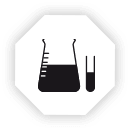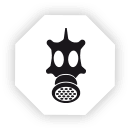Areas of work
Who could imagine a fireman without boots?
Given the risks of the profession, ETCHE Sécurité has designed boots which give protection against heat, fire, cuts, abrasion or falling objects, or also against the risks of penetration of corrosive chemicals, toxic substances or against explosion risks. In addition, the Design Department has equipped this range of boots with a high slip-resistance sole. ETCHE Sécurité boots are safer and designed for fire and emergency situations. They meet the current standards for interventions requiring a high chemical resistance.
High insulation in all weathers
Installing, maintaining or repairing a high voltage line requires specific protection. ETCHE Sécurité has developed boots capable of insulating the operator whilst working on energised equipment. These boots must be used along with the usual insulating equipments (gloves, poles, etc.) but are the only ones to protect against the "step voltage" hazard. ETCHE Sécurité boots are made of dielectric rubber and are indispensible in difficult conditions (wet ground, mud, snow) when there is a risk of impregnation by water or perspiration of leather shoes. Each of these boots are scrupulously inspected before undergoing a dielectric test.
Resistant to acids, bases, hydrocarbons or solvents
The chemical industry professional needs specific protection according to his working conditions. This is why ETCHE Sécurité offers several types of boots and shoes which must be chosen according to the chemicals present, their concentration and their temperature. In this sector, there is no room for approximation. ETCHE Sécurité products have been laboratory-tested and are compliant with the severest standards. The elastomers used have been specially formulated for high chemical and mechanical resistance and also to be antistatic to limit explosion risks in ATEX zones. This is why our boots are perfectly adapted to the chemical and petrochemical industries.
BOOTS PERMEATION TEST ACCORDING TO EN 13832-3:
| CHIMIE SA | FIREMAN SABF | HYPALON SA | NEOPRENE SA | ||
| Degradation + permeation validated |
KOP | JPQ(KR) | BLMN | JQR | |
| Acrylonitrile (C3H3N) | |||||
| Methanol (CH30H) | A | * | * | * | |
| Acetone (C3H6O) | B | * | * | ||
| Acetonitrile (CH3CN) | C | * | |||
| Dichloromethane (CH2CL2) | D | * | |||
| Carbone disulphide (CS2) | E | * | |||
| Toluene (C7H8) | F | * | |||
| Diethylamine (C4H11N) | G | * | |||
| Tetrahydrofurane (C4H8O) | H | * | |||
| Ethyl acetate (C4H8O2) | I | * | |||
| n-heptane (C7H16) | J | * | * | ||
| Sodium hydroxide (NaOH) 40% | K | * | * | ||
| Sulfuric acid (H2SO4) 96% | L | * | * | * | * |
| Nitric acid (HNO3) 65% | M | * | * | * | |
| Acetic acid (CH3COOH) 99% | N | * | * | * | |
| Ammonium hydroxide 25% | O | * | * | * | |
| Hydrogene peroxide (H2O2) 30% | P | * | * | * | |
| Isopropanol (C3H8O) | Q | * | * | ||
| Sodium hypochlorite (CLONa) 13% | R | * | * | * | |
| Hydrofluoric acid (HF) 40% | S | * | |||
| Formaldehyde (CH20) 37% | T |
*test performed according to EN 16523-1: 2015 test method
| Level | 1 | 2 | 3 | 4 | 5 |
| Normalized Breakthrough Time | 121-240 min | 241-480 min | 481-1440 min | 1441-1920 min | >1921 min |
Different professions, different risks
Metallurgy, steelmaking, raw material transformation or the automobile industry, for example, are sectors where there are multiple and often combined risks for the feet. What protection is needed for hot flying chips and cutting oil on a slippery floor? The synthetic rubbers used for our safety boots have been formulated to resist high temperatures, cuts and chemical attack. Maintenance personnel, for example, have to work in situations where the risks are multiple (cleaning or welding chemical tanks). Our waders and thigh waders are also designed to be totally waterproof, protect against the cold or against the risk of falls on the same level. They are used both by sewer workers and by bank and canal maintenance personnel, etc.
Nuclear, Radiological, Bacteriological, Chemical
The Armed Forces, hospitals, public transport and certain laboratories may be confronted with toxic agents. In the aftermath of attacks with nonconventional weapons or large-scale industrial accidents the emergency assistance must be fast and safe. To protect the intervention or decontamination teams effectively, ETCHE SECURITE has developed a model of boot which is resistant in particular to mustard gas and hydrocarbons. The NRBC boot is designed to complement filtering clothing and decontamination suits, it is therefore easily washable and can be decontaminated both internally and externally. NRBC boots also have excellent mechanical, chemical and thermal characteristics and are designed for walking on difficult ground (industrial ground, earth, rocks, etc.).
Each speciality has its specific needs
This is why ETCHE Sécurité, an attentive observer since 1932, has developed vulcanised rubber boots and shoes offering comfort and protection for each specific purpose. The ADHERAL boots, for example, meet the needs of dairy farmers in the milking room whereas the CHIMIE boots give the best protection during phytosanitary treatments. Among the ETCHE Sécurité neoprene waders and thigh waders, lined or unlined rubber boots and shoes there are models for each of the agricultural world's different needs.
Health and safety go hand in hand
This is the domain of white boots offering very high adherence on wet or greasy floors. These boots are also very easy to clean to avoid all risk of contaminating the products destined for consumption. Like all ETCHE Sécurité protective footwear, these rubber boots also have an excellent resistance to perforation, abrasion and cuts, and retain their flexibility at low temperature (cold storage rooms). The nitrile rubber used for the complete boot (upper+sole) is also resistant to heat and aggressive cleaning products.
Watch where you put your feet
In this sector, ETCHE Sécurité's Design Department is especially concerned about the risk of crushing, cuts or perforation. It has developed a high abrasion resistance rubber which is also ideal for walking on difficult ground. The foot and leg are efficiently protected and comfort is retained thanks to the material's flexibility. In some cases there is also a risk of explosion due to the presence of gas, in this case, our antistatic boots are especially recommended. Finally, chemical resistance may be necessary when processing certain minerals.
The pleasure of wearing the right footwear
ETCHE Sécurité has given priority to mechanical stress resistance and to adherence qualities for the models recommended for these sporting activities. The ankle is impact-protected and the natural rubber allows sufficient flexibility to progress easily. The boots and shoes are unlined for fast drying.
 English (UK)
English (UK) Español (ES)
Español (ES)  Français (FR)
Français (FR) 








